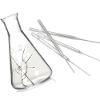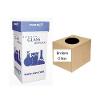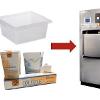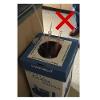Glass Waste Management
Glass waste, whether it is broken or intact, must be cleaned before disposal into an appropriate glass waste container. Glass waste containers are typically the labeled broken glass boxes available from laboratory vendors but a sturdy, labeled cardboard box with a plastic liner and sealable lid is also appropriate.
Do not dispose of anything except glass in a glass waste container. Do not overfill containers. You must be able to pop up the center cardboard to seal the box tightly. When boxes are full, they are sealed, taped closed and disposed of in a municipal dumpster by work area personnel.
Tips
- Broken glass must be handled with care. Do not handle broken glass directly with your hands; always use tools like a broom and dustpan or forceps to handle broken glass.
- Chemically-contaminated broken glass may be safer to dispose of solid chemical waste
rather than attempting to clean broken glass pieces.
- Secure chemically-contaminated glass in a sealable container and list every chemical on the orange EHS waste label.
- Biologically-contaminated broken glass should be placed in a sharps container for final disposal. If a sharps container is not available, it would need to be autoclaved or chemically disinfected before disposal in the glass waste box.
- Remove stuck on residues with an appropriate solvent (e.g., acetone, ethanol, water, etc.). Collect the solvent as chemical waste, drain, let dry and dispose of glass in a glass waste box.
- Soak intact glassware in a bleach solution for biological disinfection, drain, let dry and dispose of in a glass waste box.
- Empty glass chemical containers can be discarded in the municipal trash without the
lid. Containers must be completely empty.
- Only P-listed chemical containers need to be collected by EHS as waste.
Glass Waste Resources
Environmental Health & Safety
-
Address
Texas Tech University, 407 Flint Ave, Lubbock, TX 79409 (Mail Stop 1090) -
Phone
806.742.3876 -
Email
safety@ttu.edu




